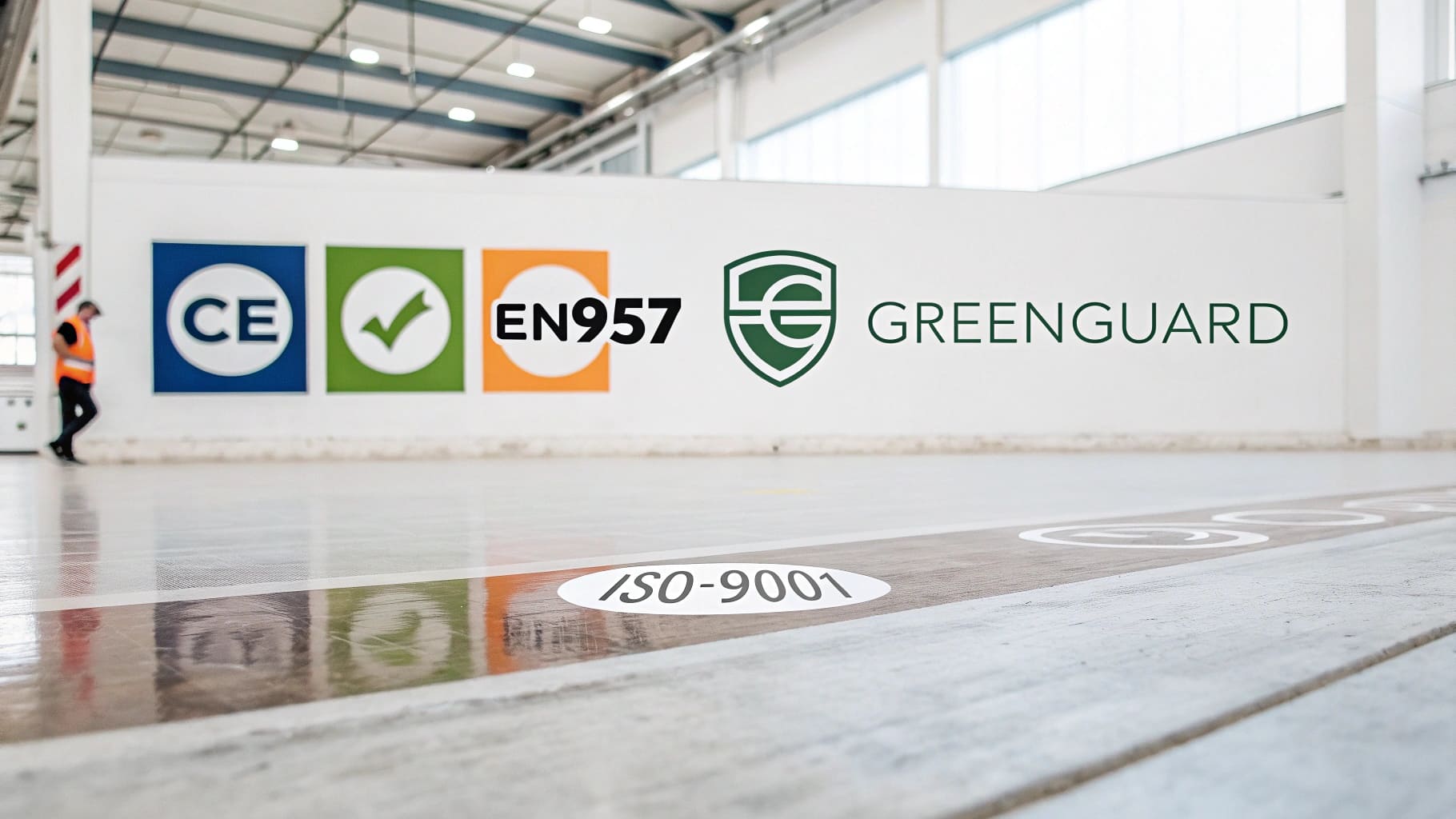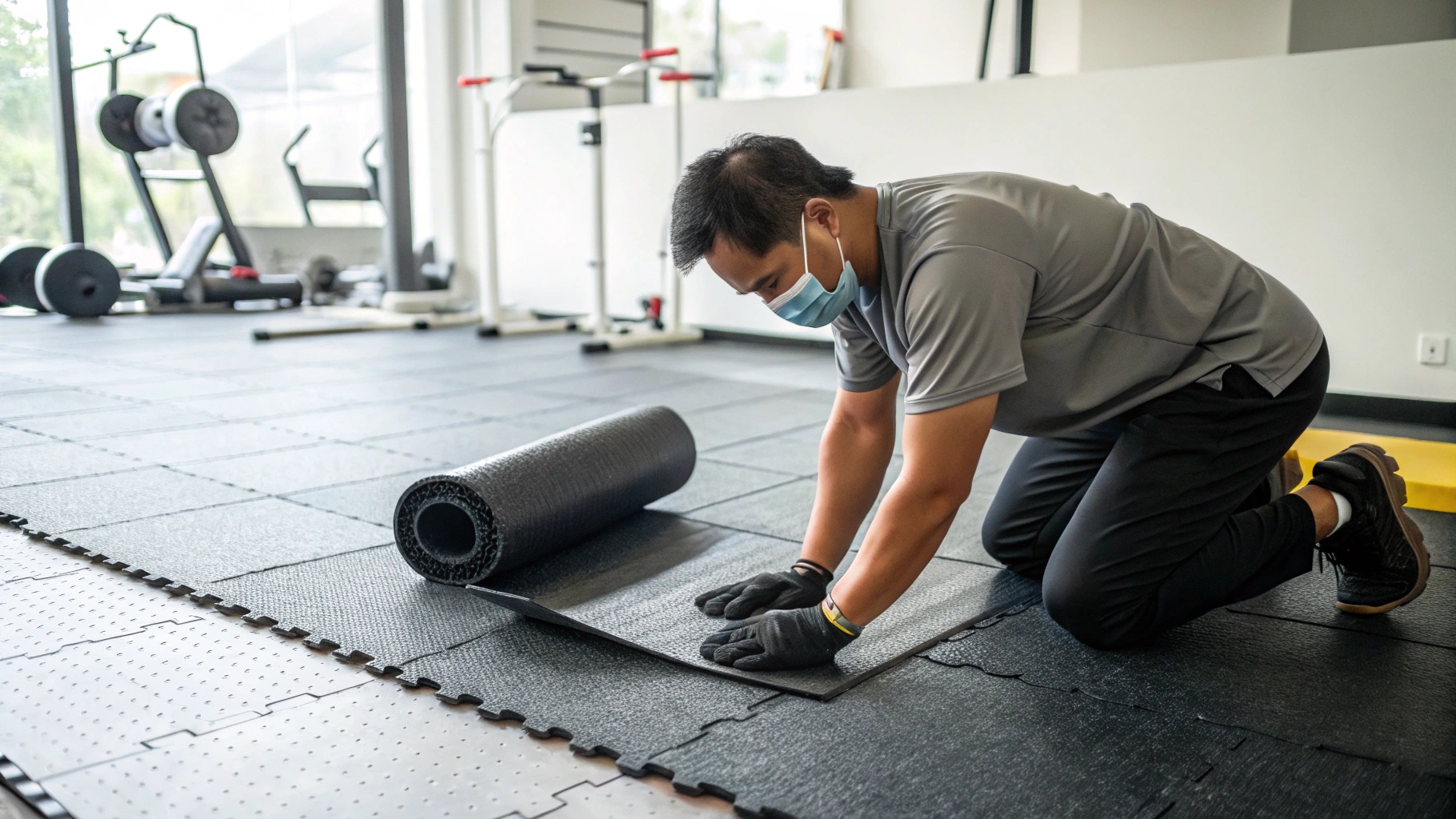The planet is heating up. You want to do your part, but it can feel like walking on eggshells trying to pick the right materials, right?
Yes, rubber flooring is generally eco-friendly, especially when made from recycled materials. It helps reduce landfill waste. Look for certifications like FloorScore or GREENGUARD to ensure low chemical emissions, making it a sustainable choice.
](https://www.byfitgear.com/wp-content/uploads/2025/03/Recycled-rubber-flooring-with-a-green-leaf-symbol.jpg) Rubber Flooring Really Eco-Friendly
Rubber Flooring Really Eco-Friendly
It’s a good start, but what about the bigger picture? Let’s explore to see if rubber really stands up to scrutiny on environmental friendliness.
How Does Rubber Flooring Compare to Other Eco-Friendly Flooring Options (e.g., Cork, Bamboo)?
Feeling overwhelmed by "eco-friendly" choices? It’s like choosing between a hybrid, an electric car, and a bicycle – each has its green claims, but which truly minimizes your footprint?
Rubber flooring1, especially recycled, tackles waste head-on. While cork and bamboo are renewable, rubber uniquely reuses existing materials, offering a different kind of environmental benefit.
](https://www.byfitgear.com/wp-content/uploads/2025/03/comparison-of-rubber-cork-and-bamboo-flooring.jpg) Comparison of Rubber, Cork, and Bamboo Flooring
Comparison of Rubber, Cork, and Bamboo Flooring
How Renewable are the Raw Materials for Rubber, Cork, and Bamboo Flooring?
| Feature | Rubber Flooring | Cork Flooring | Bamboo Flooring |
|---|---|---|---|
| Source | Often recycled tires2 | Bark of cork oak trees | Bamboo stalks |
| Renewability | Recycled content is not "renewable" | High (bark regrows every 9-12 years) | Very High (fastest-growing plant) |
Cork, like a seasoned marathoner, steadily regenerates its bark. Bamboo, the sprinter, grows at an astonishing pace. Rubber, however, is like the runner who repurposes old gear.
How Durable are Rubber, Cork, and Bamboo Flooring?
| Feature | Rubber Flooring | Cork Flooring | Bamboo Flooring |
|---|---|---|---|
| Durability | Very High | High | High, but can vary |
| Comfort | High (soft and resilient) | High (soft and warm) | Moderate (harder than cork or rubber) |
| Water Resistance | High | Moderate | Moderate to Low |
All options are durable, with rubber and bamboo showing high durability. Cork offers high comfort due to its softness.
What about the Cost and Eco-Impact?
| Feature | Rubber Flooring | Cork Flooring | Bamboo Flooring |
|---|---|---|---|
| Cost | Moderate to High | Moderate to High | Moderate |
| Eco-Impact | Low (if recycled) | Low | Low to Moderate |
Each has its strength, but using recycled rubber gives it a special edge. BYFIT’s rubber flooring, crafted from recycled materials, offers a durable and cost-effective solution.
What Are the Environmental Certifications to Look for in Rubber Flooring?
Confused by a sea of eco-labels3? It’s like trying to read a food label filled with scientific jargon – you want to make a healthy choice, but the information is overwhelming.
Beyond the usual suspects (FloorScore, GREENGUARD4), seek out an Environmental Product Declaration (EPD)5. It’s the full story, revealing a product’s complete environmental impact.
 Rubber Flooring Certifications
Rubber Flooring Certifications
What do Standard Certifications Like FloorScore and GREENGUARD Mean?
| Certification | Focus | What It Tells You |
|---|---|---|
| FloorScore | Indoor air quality6 | Low levels of volatile organic compounds (VOCs), making it safe for indoor use. |
| GREENGUARD | Indoor air quality (stricter than FloorScore) | Meets rigorous standards for low chemical emissions, ensuring minimal impact on indoor air quality. |
Standard certifications tell you about immediate impacts, like indoor air quality.
Why is an EPD Important?
| Certification | Focus | What It Tells You |
|---|---|---|
| EPD | Full lifecycle impact7 | Provides a transparent report on the product’s environmental footprint, from raw material extraction to end-of-life disposal. |
An EPD provides a complete disclosure, showing the product’s complete environmental footprint.
What about Other Certifications?
| Certification | Focus | What It Tells You |
|---|---|---|
| REACH | Chemical safety (EU regulation) | Complies with EU regulations on chemical safety. |
| RoHS | Hazardous substances (EU regulation) | Restricts the use of certain hazardous substances. |
| Cradle to Cradle | Holistic sustainability8 | Designed for circularity, considering material health, material reutilization, renewable energy use, water stewardship, and social fairness. |
These certifications address compliance and a product’s overall sustainability. BYFIT commits to transparency, providing products meeting these certifications.
What Is the Life Cycle Assessment of Rubber Flooring?
Confused about a product’s long-term impact? It’s like planning a road trip without knowing the route or the vehicle’s fuel efficiency – you might reach your destination, but at what cost?
A thorough Life Cycle Assessment (LCA)9 goes beyond the surface, revealing the total environmental cost10t of rubber flooring](https://greenrubrecycle.com/blog/post/unveiling-the-environmental-cost-traditional-flooring-vs-recycled-rubber-a-deep-dive/?srsltid=AfmBOoo7fScikkxI49tL4kuJyavRlav-g4S0kmfAI2NyOoqP-AX-MLwo)[^11], from production to disposal.
 Life Cycle Assessment of Rubber Flooring
Life Cycle Assessment of Rubber Flooring
What Happens During the Raw Material Stage?
| Stage | Description | Environmental Impacts | Potential for Improvement |
|---|---|---|---|
| Raw Material | Extraction or collection of recycled tires. | Resource depletion, energy use, emissions. | Use of recycled materials11 significantly reduces the impact. |
Using recycled materials significantly reduces environmental impact.
What are the impacts of Manufacturing Process?
| Stage | Description | Environmental Impacts | Potential for Improvement |
|---|---|---|---|
| Manufacturing | Processing raw materials into rubber flooring products. | Energy use, emissions, waste. | Renewable energy, water recycling, waste minimization, efficient processes. |
Improving manufacturing processes12 is key.
How Does Transportation Affect the Environment?
| Stage | Description | Environmental Impacts | Potential for Improvement |
|---|---|---|---|
| Transportation | Distribution from factory to consumer. | Emissions, air pollution. | Optimized routes, fuel-efficient vehicles, local sourcing. |
Transportation’s impact needs to be considered.
What to Consider during Installation?
| Stage | Description | Environmental Impacts | Potential for Improvement |
|---|---|---|---|
| Installation | Installing rubber flooring. | VOC emissions, waste. | Low-VOC adhesives, recycling, minimizing waste. |
Installation impacts can be addressed through mindful practices.
What is the impact during the use?
| Stage | Description | Environmental Impacts | Potential for Improvement |
|---|---|---|---|
| Use | Period flooring is in use. | Minimal, cleaning impacts. | Eco-friendly cleaning, proper maintenance. |
Proper maintenance extends the lifespan and reduces impact
How about the End-of-Life Stage?
| Stage | Description | Environmental Impacts | Potential for Improvement |
|---|---|---|---|
| End-of-Life | Disposal or recycling of rubber flooring. | Landfill, incineration, or recycling impacts. | Design for recyclability, effective recycling, closed-loop systems. |
Circularity focuses on reusing materials, turning waste into a valuable resource. BYFIT is emphasizing recycled materials and sustainable products.
Conclusion
Rubber flooring, particularly from recycled sources, stands out as an environmentally sound choice. It’s can help solve the waste. Look for complete certifications, and you’re not just choosing a floor. You are choosing a future.
-
Explore the unique advantages of rubber flooring, especially its eco-friendly aspects and durability, to make an informed choice. ↩
-
Discover how recycled tires contribute to sustainable flooring solutions, reducing waste and promoting eco-friendliness. ↩
-
Exploring eco-labels can help you navigate sustainable choices more effectively, ensuring you support environmentally friendly products. ↩
-
Learning about these certifications can enhance your knowledge of product safety and sustainability, guiding you towards better purchasing decisions. ↩
-
Understanding EPDs can empower you to make informed choices about products’ environmental impacts, leading to healthier decisions for you and the planet. ↩
-
Understanding indoor air quality certifications can help you choose safer products for your home or office environment. ↩
-
Exploring full lifecycle impact helps you understand the environmental effects of products from start to finish, promoting sustainable choices. ↩
-
Learning about holistic sustainability can guide you in selecting products that are environmentally friendly and socially responsible. ↩
-
Understanding LCA is crucial for evaluating the environmental impact of products. Explore this link to gain insights into its methodology and benefits. ↩
-
Learn how to assess the total environmental cost of products, which is essential for sustainable decision-making. This link offers comprehensive guidance. ↩
-
Exploring this resource will provide insights into how recycled materials can reduce environmental impact and promote sustainability. ↩
-
This link will offer valuable strategies for enhancing manufacturing efficiency and reducing environmental harm. ↩

](https://www.byfitgear.com/wp-content/uploads/2025/03/recraft-instruction-objective-create-vi.jpg)

